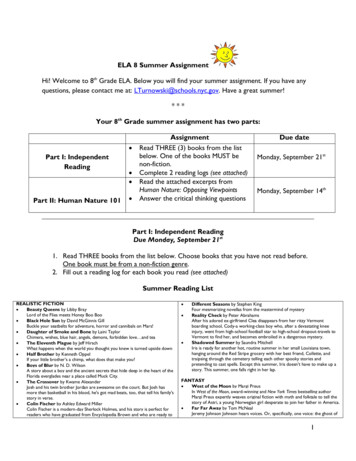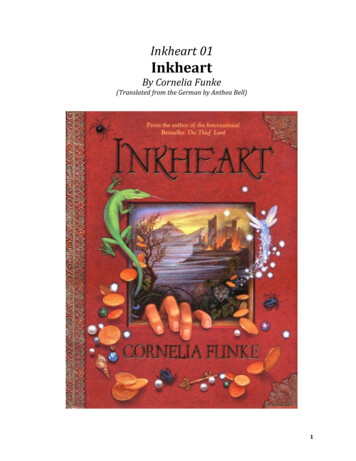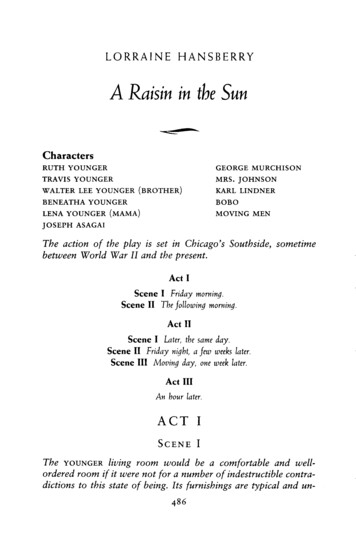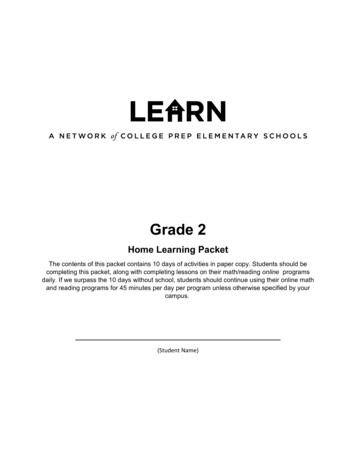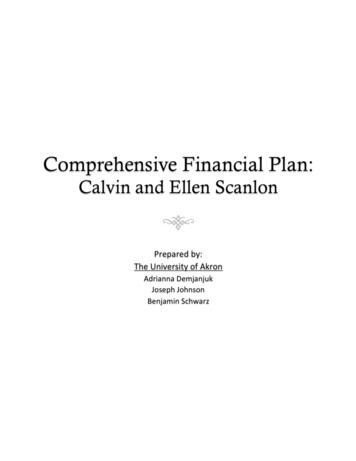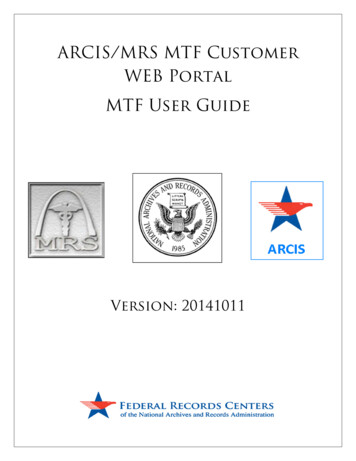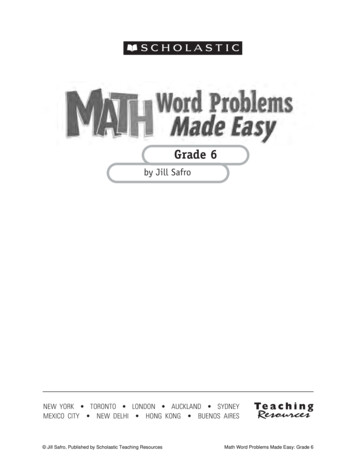
Transcription
Grade 6by Jill SafroNEW YORK TORONTO LONDON AUCKLAND SYDNEYMEXICO CITY NEW DELHI HONG KONG BUENOS AIRES Jill Safro, Published by Scholastic Teaching ResourcesMath Word Problems Made Easy: Grade 6
Scholastic Inc. grants teachers permission to photocopy the activity sheets from this book for classroom use. No other part of thispublication may be reproduced in whole or in part, or stored in a retrieval system, or transmitted in any form or by any means,electronic, mechanical, photocopying, recording, or otherwise, without written permission of the publisher. For informationregarding permission, write to Scholastic Inc., 557 Broadway, New York, NY 10012.Cover design by Maria LiljaInterior design by Holly GrundonInterior illustrations by Mike MoranISBN 0-439-52974-3Copyright 2005 by Jill SafroAll rights reserved.Printed in the U.S.A.1 2 3 4 5 6 7 8 9 10Math Word Problems Made Easy: Grade 64012 11 10 09 08 07 06 05 Jill Safro, Published by Scholastic Teaching Resources
C o n t e n tsIntroduction . . . . . . . . . . . . . . . . . . . . . . . . . . . . . . . . . . . . . . . . 4The Fantastic Five-Step Process . . . . . . . . . . . . . . . . . . . . . . . . . 6The Amazing Eight Strategies . . . . . . . . . . . . . . . . . . . . . . . . . . 91Choose an Operation. . . . . . . . . . . . . . . . . . . . . . . . . . . 102Guess and Check . . . . . . . . . . . . . . . . . . . . . . . . . . . . . . 123Draw a Picture . . . . . . . . . . . . . . . . . . . . . . . . . . . . . . . . 144Make a List, Table, or Chart . . . . . . . . . . . . . . . . . . . . . . 165Identify Too Much or Too Little Information . . . . . . . . . . 186Find a Pattern . . . . . . . . . . . . . . . . . . . . . . . . . . . . . . . . 207Use Logical Reasoning . . . . . . . . . . . . . . . . . . . . . . . . . . 228Work Backward . . . . . . . . . . . . . . . . . . . . . . . . . . . . . . . 24The Happy Hundred Word Problems . . . . . . . . . . . . . . . . . . . . 26Number and Operations . . . . . . . . . . . . . . . . . . . . . . . . 27Algebra . . . . . . . . . . . . . . . . . . . . . . . . . . . . . . . . . . . . . 55Geometry and Measurement . . . . . . . . . . . . . . . . . . . . . 64Probability . . . . . . . . . . . . . . . . . . . . . . . . . . . . . . . . . . . 71Reasoning . . . . . . . . . . . . . . . . . . . . . . . . . . . . . . . . . . . 72Answer Key . . . . . . . . . . . . . . . . . . . . . . . . . . . . . . . . . . . . . . . 77 Jill Safro, Published by Scholastic Teaching ResourcesMath Word Problems Made Easy: Grade 6
I n t ro d u c t i o nhen it comes to ranking math skills, problem solving is ontop of the list. Literally. It’s number one on the processstandards listed in the Principles and Standards for School Mathematics(NCTM, 2000). According to the National Council of Teachers ofMathematics (NCTM), “Problem-solving should be the central focusof all mathematics instruction and an integral part of all mathematicalactivity.” In other words, problem solving is what math is all about.When learning to read, we learn to recognize the letters of thealphabet, we practice letter–sound relationships, and we learnpunctuation. But the goal is to eventually read text. The same goesfor math. We learn how to recognize and write numerals, deciphersymbols, determine numerical order, and work with operations likeaddition and subtraction. But what matters most is what we cando with these skills—applying what we know to solve problems indaily life.Math Word Problems Made Easy: Grade 6 is designed to help youhelp students sharpen their problem-solving abilities (and share achuckle or two along the way). This book is divided into three mainsections to help you:WThe Fantastic Five-Step Processhe first section describes a simple five-step problem-solvingprocess and an introductory lesson you can share with yourstudents. This process can be used with every math word problemthey might encounter. This is a valuable concept to introduce atthe beginning of the year and practice with students so that theywill have an approach they can rely on as they encounter varioustypes of problems throughout the year.T4Math Word Problems Made Easy:Grade 6 Jill Safro, Published by Scholastic Teaching Resources
The Amazing Eight Strategiesection two takes a look at the different types of problemsstudents might encounter and describes eight strategies toconsider when solving them. We discuss each strategy and providesample problems (and solutions) so students can practice andmaster the strategy. You may want to introduce a new strategy everyweek, so that students will be thoroughly familiar with all the basicstrategies and have had practice with them by the end of the secondmonth of the school year.SThe Happy Hundred Word Problemsere you’ll find 100 word problems that focus on mathconcepts specific to sixth grade. They’re all written sostudents will find them interesting and fun.The problems are arranged by mathematical standards. Thereare sections for Number and Operations, Algebra, Geometry,Measurement, Probability, and Reasoning. The problems areprinted two to a page, leaving plenty of room for students to showtheir thinking. Use the problems to introduce concepts, practicestrategies, or as an end point to check for understanding.Hearning a consistent problem-solving approach, becomingfamiliar with and practicing effective problem-solvingstrategies, and applying these ideas in word-problem contextshelp students become more effective problem solvers andmathematicians. And with Math Word Problems Made Easy:Grade 6, they just might enjoy themselves while doing so.LMath Word Problems Made Easy: Jill Safro, Published by Scholastic Teaching ResourcesGrade 65
The FantasticFive-Step Processhat do you do when you first encounter a math word problem?This is what we need to help students deal with. We need tohelp them develop a process that they can use effectively to solve anytype of math word problem. The Five-Step Process will help studentsorganize their interpretation of and thinking about word problems.The best way to help students understand the process is todemonstrate how to use it as you work through a problem on the boardor overhead. Make a copy of the graphic organizer below. You can blowthis up into a poster or provide each student with his or her own copyto refer back to as you bring students through this introductory lesson.6LVEChooSTRATEG se aY and SOWhat can weELIMINATE?s theWhat iION?QUESTethert a TS?ahW FACWrwesan SE?eNhs t SEeEDo AKMMath Word Problems Made Easy:Grade 6 Jill Safro, Published by Scholastic Teaching Resources
Step 1: What Do We Know?Begin by writing this problem on the board or overhead.Every year, Wienerville, Wisconsin, has a hot dog-eatingcontest. This year, there were four contestants. LittleFrankie Footer ate 58 dogs. His brother Benny ate3 times as many. Their friend, Phyllis, ate 180. Herbrother Doug didn’t eat any. Benny says he won thecontest. Did he? How many dogs did he devour?Read the problem carefully. What are the facts? Have studentsvolunteer these orally. Write them on the board.Frankie Footer ate 58 hot dogs.Benny ate 3 times as many as Frankie.Phyllis ate 180 hot dogs.Doug didn’t eat any.Encourage students to write down the facts. This will help them focuson what is important while looking for ways to put it in a more accessibleform. Can we arrange the facts in a way that will help us understand theproblem situation? For instance, maybe it would be helpful to draw whatwe know, or put it in a list, or make a table. Sometimes it’s helpful toarrange numbers from lower to higher or higher to lower, especially if weare asked to compare.Step 2: What Do We Want to Know?What is the question in the problem? What are we trying to find out? Itis a good idea to have students state the question and also determine howthe answer will be labeled. For example, if the answer is 180, then 180what? 180 pumpkins? 180 fish? In this case, it’s hot dogs.We want to know two things:1. Did Benny win the contest?2. How many hot dogs did Benny eat?Math Word Problems Made Easy: Jill Safro, Published by Scholastic Teaching ResourcesGrade 67
Step 3: What Can We Eliminate?Once we know what we’re trying to find out, we can decide what isunimportant. You may need all of the information, but usually thereis some extra information that can be put aside.We can eliminate the fact that Doug didn’t eat anyhot dogs. Obviously he didn’t win the contest.Step 4: Choose a Strategyor Action and SolveIs there an action in the story (for example, something being taken away orshared) that will help decide on an operation or a way to solve the problem?Since we know that Benny ate 3 times as many asFrankie, we need to multiply Frankie’s total (58) by 3:58 x 3 174Benny ate 174 hot dogs! That’s less than Phyllis’s 180.He lost the contest, because 180 is a greater numberthan 174.Step 5: Does My Answer Make Sense?Reread the problem. Look at the answer. Is it reasonable? Is it a sensibleanswer given what we know?It makes sense. 180 is higher than 174, and 174 ishigher than 58. If the product was lower than 58,that would be a problem because the product of twopositive numbers cannot be lower than the multiplicand.Try a few different word problems using this “talk through” format withstudents. You can use sample problems from this book. Ask students totake a stab at the problem themselves first, and then do the step-by-stepprocess together. Practicing the process in this way helps make it a part ofa student’s way of thinking mathematically.8Math Word Problems Made Easy:Grade 6 Jill Safro, Published by Scholastic Teaching Resources
TheA mazing E ightStrategiesWhile we shouldencourage the use of theFive-Step Process to approachany problem, Step 4 (Choose aStrategy or Action and Solve)includes a wide range of choices.Some common strategies thatare helpful to teach and practiceare listed on the next few pages,along with sample problems.Students should have experiencewith all of the strategies. Themore practice they have, theeasier it is for them to choose astrategy that fits the problemand helps deliver an answer.TipAs students learn about and practiceusing these strategies to solveproblems, ask them to create their ownword problems. You can list the mathconcepts you want them to use in theproblems (such as multiplication orfractions) and even the strategy thatmust be used to solve it. Students usethese parameters to create their ownproblems, which they can share and tryout with one another. As studentsbegin to play with these elements, theirknowledge of how problems workgrows, as does their confidence whenencountering new problems.Math Word Problems Made Easy: Jill Safro, Published by Scholastic Teaching ResourcesGrade 69
Strategy 1:C hooseanO perationEven the most straightforward problemrequires a mathematical operation to solve it.The question is, which one? After examining theinformation presented in a problem, students mustChoose an operationdecide which operation (addition, subtraction,multiplication, or division) they should use to solve it.Instruct them to read the problem and look for keywords and phrases, such as “all together” or “more than” that may help move themin the right direction when choosing an operation. Then have them write an actualequation and solve.Sa m ple P rob lemUncle Otto ate a whole pumpkin pie in 21 minutes flat. Cousin1Orville ate a whole pie in — of that time. How long did it take3Orville to eat the pie?Solution13Otto ate the pie in 21 minutes. Orville’s time was — ofthat. One operation we could use to figure out Orville’s timeis division. With the information in the problem, we cancreate an equation:21 3 ?Answer: It took Orville 7 minutes to eat the whole pie.10Math Word Problems Made Easy:Grade 6 Jill Safro, Published by Scholastic Teaching Resources
9 7 16 4 20 – 7 13Sa m ple P rob lems1. Omar found 56 cents under a couch cushion! He lost half through a hole inhis pocket. How much did Omar lose?2. Villesville, Virginia, was founded on November 18, 2004. In what year will itcelebrate its bicentennial (that’s its 200th birthday!)?13. Speedy Spotty can run a mile in 33 minutes. Fiesty Fido can do it in — the3time. How long does it take Fido to finish a mile-long run?4. The Micro Motel is the tallest tower in Tiny Town. It’s 10 times taller thanTony’s Tiny Trumpet Store. Tony’s store is 2 inches tall. How tall is the MicroMotel?A nsw e rs1. 28 cents (subtraction)3. 11 minutes (division)2. 2204 (addition)4. 20 inches tall (multiplication)Math Word Problems Made Easy: Jill Safro, Published by Scholastic Teaching ResourcesGrade 611
Strategy 2:G uess&C heckIf you’re not sure how to tackle a word problem,begin with a reasonable guess to get you started.Urge students to apply their estimation skills. This is thekey to making a “reasonable” guess. Even just this firststep is worth practicing. Then when a first attemptedanswer is arrived at, consider whether the answer isreasonable, too high, or too low. This is the “check” partguess & checkof Guess and Check.After considering the answer, have students decide ifthey need to revise and if so, how. Would a higher answer make sense? A lower answer? Trythe following problem on the board and think aloud through the steps. Discuss the problemwith students as you decide on your first attempt. Explain why you chose that number andhow you are examining the number to determine if it is reasonable. Talk about how you areadjusting your initial attempt and why.Sa m ple P rob lemPenelope Pig is eating her way through Cooter’s Candy-Coated Bugs Shop.When she got there, there were two 5.25 chocolate-covered centipedeson the display shelf. There were also ten 2 caramel-coated spiders and six 1.50 cockroaches dipped in white chocolate. Penelope eats all but 3 ofthe candy-coated bugs. The 3 bugs are worth 8.25. What’s left?SolutionAccording to the problem, Penelope ate all but 8.25 worth of bugs andonly 3 bugs were left.Let’s say one of each kind of bug is left: 5.25 2 1.50 8.75.The sum is too high! It seems reasonable that one of the bugs left is thecentipede ( 5.25) because its price will get us close to the desired total.We know that the other two bugs must be the same kind. What would giveus the difference between the 8.25 total and the 5.25 centipede?Let’s try the cockroaches: 5.25 1.50 1.50 8.25 The answerchecks out. Penelope did not eat 1 centipede and 2 cockroaches.12Math Word Problems Made Easy:Grade 6 Jill Safro, Published by Scholastic Teaching Resources
Jill Safro, Published by Scholastic Teaching Resources
Strategy 3:D rawaP ictureDrawing a picture can help answer the question,“What do we know?” Sometimes words do noteasily convey the facts. Sometimes they can evenconfuse. By having students draw what they know,the problem can become clearer, the facts more easilymanipulated, and relationships more quicklydiscovered.When students use drawings or diagrams to helpsolve problems, remind them to use simple symbols torepresent elements in a problem, such as stick figures forpeople. Unnecessary details or coloring should be left out.draw a pictureSa m ple P rob lemIf there’s one thing the Frost family enjoys, it’s building snowmen.Today, they built 12! They put black hats on half of the snowmen.One third of the snowmen got red hats. After that, the Frosts ranout of hats. So the rest are wearing wigs. How many snowmen arewearing wigs?SolutionAnswer: 2 snowmen are wearing wigs14Math Word Problems Made Easy:Grade 6 Jill Safro, Published by Scholastic Teaching Resources
9 7 16 4 20 – 7 13Sa m ple P rob lems1. Randy the roofer finished 6 roofs today. Unfortunately, he was hired to do14! Half of the unfinished roofs are covered in blue plastic. One-fourth ofthe unfinished roofs are covered in red plastic. And the rest are covered inpolka-dotted plastic. How many roofs are covered with polka dots?2. Carrie’s head is full of curlers. There are 16 in all. One-fourth of the curlersare pink. There are twice as many green curlers as pink ones. The rest aresoda cans. How many cans are on Carrie’s head?13. Morey mowed half of Mickey’s lawn. Matty mowed — as much as Morey4did. Midge mowed twice as much as Matty. How much of Mickey’s lawn hasnot been mowed?4. Mr. Mozzarella’s sixth-grade class is having a pizza party! Half of the pie iscovered with peanuts. One-third of the pie has pecans. The rest haspistachios. How much of the pie has pistachios?A nsw e rs1. 2 roofs3.2. 4 cans4.1—81—6of the lawn is unmowedof the pie has pistachiosMath Word Problems Made Easy: Jill Safro, Published by Scholastic Teaching ResourcesGrade 615
Strategy 4:Make a L ist,Table, or ChartThis strategy helps us identify and organizewhat we know. For example, in problemswhere combinations must be determined, listing allpossible combinations is essential to see if studentshave considered all the possibilities. Setting uptables or charts can also help reveal patterns orrelationships that may exist in sets of data.make a list, table, or chartSa m ple P rob lemPeter Pumpernickel is hosting a party to celebrate SandwichAppreciation Month. The cold-cut platter includes salami, bologna,and pastrami. How many kinds of sandwiches can Peter’s guestsmake?SolutionTo solve this problem,students should make asystematic list to keeptrack of all the possiblecombinations:4. salami and bologna1. salami7. bologna and pastrami2. bolognaAnswer: 7 possible cold-cutcombos3. pastrami165. salami and pastrami6. salami, bologna, andpastramiMath Word Problems Made Easy:Grade 6 Jill Safro, Published by Scholastic Teaching Resources
9 7 16 4 20 – 7 13Sa m ple P rob lems1. Crafty Carla is dressing a scarecrow for her garden. She has 4 shirts (brown,green, blue, and pink), 2 kinds of pants (red velvet sweatpants and orangevelvet sweatpants), and 3 hats (a baseball cap, a top hat, and a ski cap).How many different outfits can she make for the scarecrow?2. Darius the doorman needs a new look. He has 4 hats (a beret, a captain’shat, a Statue of Liberty hat, and mouse ears). He has 3 types of shoes(slippers, flip-flops, and tap shoes). How many combinations of one hatand one type of shoes can he make?3. The 6 members of the Beverly Hills Sandwich Appreciation Club are having ameeting. Each member will serve a sandwich to every other member of theclub (but not themselves). How many sandwiches will be served at themeeting?4. Holly, Carlyle, Sarah Jane, and Bryan are competing in the Fourth AnnualOne-Legged Race! They’re now on the last leg of the race. How manydifferent ways could they finish?A nsw e rs1. 24 outfits3. 30 sandwiches2. 12 combinations4. 24 waysMath Word Problems Made Easy: Jill Safro, Published by Scholastic Teaching ResourcesGrade 617
Strategy 5:Identify T oo Muchor Too L ittleI nformationIn the real world, we sometimes encounter situationsin which we have too much or too little informationto solve a problem. The same goes in the math world.Often, word problems contain information that isn’tneeded to find the solutions. In this case, it’s best to readthe question carefully, then go back and focus on theIdentify too much ornumbers and facts needed to answer the question.too little InformationSuggest that students cross out any irrelevant facts andnumbers to simplify the word problem, if necessary.Other times, a problem may be missing key bits of information necessary to solve theproblem. While such problems rarely appear on standardized tests, it’s good practice forstudents to learn to identify what information they would need to solve such a problem.Sa m ple P rob lemDoogie McDougal is whipping up 72 different snacks for his112th annual Blooper Bowl bash. He invited 138 guests—but only —6are coming. That doesn’t bother Doogie. He still makes 100 bowlsof nacho dip. He makes twice as many bowls of chili. How manyguests are coming to the party?SolutionThere is more information than we need to solve this problem.The question is how many guests are coming to Doogie’sparty. To figure this, we divide 138 by 6 (since1—6of theinvited guests plan to attend). Answer: 2318Math Word Problems Made Easy:Grade 6 Jill Safro, Published by Scholastic Teaching Resources
9 7 16 4 20 – 7 13Sa m ple P rob lems1. Darla won the dance marathon! She danced 3 hours longer than Danny.Danny danced 5 hours longer than Daryl. And Daryl danced 5 minutes morethan Myrtle. Is there enough information to figure out how long Darladanced? Explain.2. Horace bought 70 souvenirs at Stanley’s Souvenir Shack at 1:15 P.M.Each souvenir cost 1.30 and weighed 17 pounds. He put 3.90 worthof souvenirs in his backpack and 6.50 worth in his briefcase. He put therest in a wagon at 3:20 P.M. How much did Horace spend on souvenirsat Stanley’s?3. Patty Peters has two pools filled with prune juice. Pool One has 573 moregallons of juice than Pool Two. What information do you need to figure outhow much prune juice Patty has in both pools?4. It’s feeding time at the Zanyville Zoo. That means its 10:12 in the morning!The zookeeper gives 600 candy apples to the 72 kangaroos. That takes 20minutes. He throws 16 pecan pies to the 27 porcupines. That takes 15minutes. Finally, he gives 837 peanut-butter sandwiches to 200 polar bears.That takes a total of 18 minutes. At what time does the zookeeper finishfeeding these Zanyville Zoo residents?A nsw e rs1. No; we need to know howlong Myrtle danced.3. How much juice is in Pool Two?4. 11:05 A.M.2. 91Math Word Problems Made Easy: Jill Safro, Published by Scholastic Teaching ResourcesGrade 619
Strategy 6:FindaP atternUsing lists and drawing pictures can help revealpatterns that may exist within the informationa problem supplies. To discover patterns, ask: Whatrelationships do you see between the numbers in theproblem? How far apart are the numbers from eachother? Do they increase or decrease by certainamounts in certain ways? Remind students thatfind a patternasking these questions will often lead to a good[ART:solution.STRATEGY SYMBOL]Sa m ple P rob lemRusty spent 10 to mail a 10-pound watermelon to his UncleLouie in Louisville. Rusty’s brother Bucky spent 12 to send a12-pound watermelon. It cost their sister Cindy 14 to send UncleLouie a 14-pound watermelon. How much did sister Samanthaspend to send a 20-pounder to Uncle Louie?AnswersSolutionNotice how the dollar amounts in this problem match theweights of the watermelons mailed. The pattern shows thatit costs a dollar for every pound of watermelon mailed. Wecan surmise that a 20-pound watermelon would cost 20.Answer: 2020Math Word Problems Made Easy:Grade 6 Jill Safro, Published by Scholastic Teaching Resources
9 7 16 4 20 – 7 13Sa m ple P rob lems1. Tony the tap dancer practices 20 minutes every Monday. On Tuesdays, hepractices tapping for 30 minutes. On Wednesdays, Tony taps for 40minutes. If he continues this pattern, how long does Tony tap on Saturdays?2. Gross Gus is so gross! He just burped, burped, sneezed, burped, burped,and sneezed. Then he burped, burped, sneezed, burped, burped, sneezed,and burped? If the pattern continues, what will he do next?3. Chef Jeff is making a very special lasagna. The bottom layer is peanut butter.The next layer is cream cheese. Next comes a layer of jellybeans, followedby peanut butter, then cream cheese, then jellybeans. What is the next layermade of?4. Pink, pink, purple, green, stripes, stripes, stripes. Pink, pink, purple, green,stripes, stripes, stripes, pink, pink, purple . . . What comes next?A nsw e rs1. 70 minutes3. Peanut butter2. Burp4. GreenMath Word Problems Made Easy: Jill Safro, Published by Scholastic Teaching ResourcesGrade 621
Strategy 7:Use L ogicalR easoningLogical reasoning is a way to help studentsorganize data and use the process ofelimination to solve problems. Logic boxes and logiclines (see page 80) are helpful tools for organizingfacts and using the process of elimination.use logical reasoningSa m ple P rob lem 1Skippy, Steve, and Stanleyare on their way to a familyreunion. One is traveling byhot-air balloon, another byblimp, and the third by pogostick. Who’s on the pogostick? Use these clues tofigure it out: Steve is afraid of blimps. Stanley is afraid of pogosticks. Skippy loves balloons.SolutionPogoFrom the clues, we know that SteveBlimpBalloonStickwon’t travel by blimp. Put an X in theSteve logic box next to Steve under Blimp.Stanley is afraid of pogo sticks so put Stanley an X next to Stanley under Pogo Stick.Skippy Skippy loves balloons so put a checknext to Skippy under Balloon, and Xout Pogo Stick and Blimp. X out the rest of the Ballooncolumn. If Steve isn’t in the balloon or blimp, he must beon the pogo stick. Answer: Steve is on the pogo stick.Sa m ple P rob lem 2The airplane was invented afterthe telephone and peanutbutter. George WashingtonCarver invented peanut butterafter Alexander Graham Bellgave us the telephone. Whichinvention came first?SolutionTo solve, draw a logic line. We know that peanut buttergoes to the left of the airplane and that the telephonegoes to the left of peanut butter. Answer: The telephonewas the first to be invented of the three.FirstLasttelephone22peanutbutterairplaneMath Word Problems Made Easy:Grade 6 Jill Safro, Published by Scholastic Teaching Resources
9 7 16 4 20 – 7 13Sa m ple P rob lems1. Ignacious Whistlewhite invented an electric pinwheel (no wind necessary!).He invented it before he invented the glow-in-the-dark frying pan, but afterthe edible wallpaper. He invented an underwater television after the ediblewallpaper, but before the electric pinwheel. What did he invent first? Use alogic line to find out.2. Troy, Trevor, and Trina are the Trippety triplets. They’re also super athletes.One is a world-class swimmer. Another is a medal-winning bicyclist. Thethird is a top tennis player. Who is the bike champ? Use the clues and alogic box to find out. Trina needs a partner to play. Trevor is afraid of water.3. There are four U.S. states that have names starting with the letter “A.”Arkansas has more residents than Alaska, but fewer than Arizona. Alabamahas fewer residents than Arizona, but more than Arkansas. Which of the “A”states has the greatest population?4. Zach, Zeke, Jere, and Jerry brought their pet cat, fish, dog, and snake to the vetfor a checkup. But the vet’s brand-new assistant mixed up all the animals. Usethe clues and a logic box to help her figure out which pet belongs to who: Zeke is allergic to cats. Jere and Zeke are afraid of dogs. Jerry loves to watch his pet swim all day.1. Edible wallpaper2. Trevor is the bicycle champ3. ArizonaA nsw e rs4. Zach owns the dog, Zeke has thesnake, Jere gets the cat, and Jerryowns the fish.Math Word Problems Made Easy: Jill Safro, Published by Scholastic Teaching ResourcesGrade 623
Strategy 8:Work B ackwardWWorking backward is a goodstrategy to use when we knoworkingis adon’tgoodknowstrategy tohow a problem backwardsends up, butemployThewhenwe isknowhow a problem endshow it started.trickto knowup,buttowebegindon’tandknowhow itaboutstarted. For example, ifwhereto thinkIusingwentinverseto the storeand bought a hammer for 2.50operations.and the clerk gave me 2.50 change, how muchwork backwardmoney did I give the clerk to begin with? It is still amatterof applyingthe FiveStep Process andSam pleP roblemorganizing information first, but the trick here is toknow where to begin and to think about usingDonovanDoogleboughta bag ofat the Dingalinginverseoperations.These typesof problemsarepeanutsafeedspeanutsto Elwoodgreat BrothersopportunityCircus.to help Hestudentsseehalfthe theusefulnessof usingletters orthesymbols present unknown quantities. For example with the hammer problem we could think:Donovan eats the last 3 peanuts himself. How many peanutsI gave the clerk “x.” And since I got back 2.50 and the hammer costs 2.50 thenwere in the bag to begin with? 2.50 2.50 “x.”Solution To solve the problem, students can work backward. At theproblem’s end, Donovan ate 3 peanuts. Before that, he fedMarvin 4 peanuts. That’s 3 4, or 7 peanuts. Before that, Donovan fed Elwood the elephant half of thepeanuts. He had 7 peanuts after that, so he must have hadtwice as many peanuts before. That’s 7 x 2, or 14 peanuts.Answer: The bag had 14 peanuts in all. Have students work forward to check the answer. See ifthe problem works if Donovan began with 14 peanuts.24Math Word Problems Made Easy:Grade 6 Jill Safro, Published by Scholastic Teaching Resources
9 7 16 4 20 – 7 13Sa m ple P rob lems1. Mervin Moneybags went on a spending spree today. He spent half of hismoney on a Slammy So-so baseball card. He spent 50 on a pair ofpuppies. And he blew his last 25 on a broken bike. How much money didMervin spend today?2. Anna finished the Walk-on-Your-Hands race in just 3 days! She walked onemile today. Yesterday, she walked 3 times the distance she walked on thefirst day. On day one, she walked 160 miles. (She spent the rest of theweek applying hand lotion.) How long was the race?3. Aunt Eloise wrote all of her Happy New Year cards in one day. She wroteof them while she ate a burrito for breakfast. She finished off 43 cardswhile she ate lima beans for lunch. And she did the final 57 while shedevoured a doughnut for dinner. How many cards did Aunt Eloisewrite today?1—24. Myron the muffin-maker made a special batch of huckleberry muffins thismorning. He sold half the batch to Rudy the roofer. Then he sold 18 muffinsto Bea the ballerina. He gave away half that amount to the Muffin Museum.And he ate the last muffin himself. How many muffins did Myron make thismorning?A nsw e rs1. 1503. 200 cards2. 641 miles4. 56 muffinsMath Word Problems Made Easy: Jill Safro, Published by Scholastic Teaching ResourcesGrade 625
TheHa
Otto ate the pie in 21 minutes. Orville’s time was of that. One operation we could use to figure out Orville’s time is division. With the information in the problem, we can create an equation: 21 3 ? Answer: It took Orville 7 minutes to eat the whole pie. Solution Sample Problem 10 Math Word P

